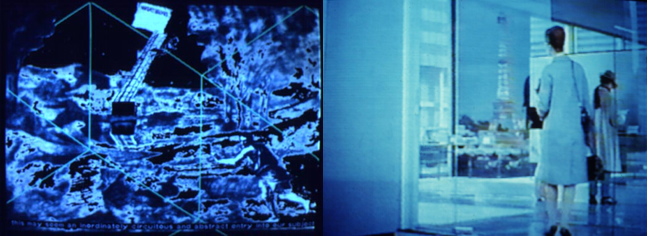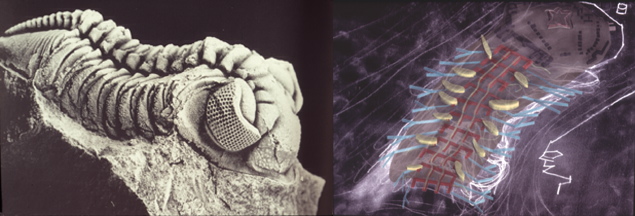The French terms of both agencement and dispositif used by Deleuze and Guattari are usually translated as assemblage. An assemblage is a "site at which a discursive formation intersects with material practices" (Jonathan Crary, Techniques of the Observor, p. 31) It is "simultaneously a machinic assemblage and an assemblage of enunciation" (D+G, Thousand Plateaus, p. 504)
Read Moremachinic
automobile
"With the advent of the motor-car the poet, painter, intellectual, was no longer a passive recipient of technological experience, but could create it for himself." (Banham, Theory and Design, p 102)
Read Morecyborg
Is the cyborg an improved hybrid species that has the capacity to be humanity's evolutionary successor? This is the starting point for Manuel DeLanda's evocation of future "robot historians" writing the history of " War in the Age of Intelligent Machines." Warfare has been the primary arena for the technological development of cybernetics, but the cyborg has become a figure that brings toget her science fiction and technology in unexpected combinations. If the Terminator and Robocop exemplify some of the issues of aggression for a masculine image of the cyborg in the contemporary imagination, the concept has been developed in a feminist perspective as well.
Read Moredesiring machines
In the Anti-Oedipus, subtitled Capitalism and Schizophrenia, volume 1, and first published in 1972, Gilles Deleuze and Félix Guattari engaged in a radical critique of Freudianism. Like their contemporary, R.D. Laing, and like Wilhelm Reich before them, they linked psychic repression with social repression, and sought to recover the revolutionnary quality of desire.
Read Moremachine
"Machine is derived via the Latin machina and from the Greek mechane , meaning tool or machine -- especially an instrument to lift heavy objects, a crane, or a military engine. Perhaps the original word is mëxos, which means an artificial device, especially used against misfortune and troubles.
Read Moreorrery

An Orrery is a clocklike object which models the movements of the solar system. The orrery is often referred to as the paradigmatic embodiment of the Newtonian "clockwork"universe. Note that the orrery, like Newtonian time, could conceivably rotate in either direction. What was the origin of "clockwise" motion? Should we see it as one of those bifurcations that could equally have gone either way? Newton believed that from time to time the Creator had to interfere in the course of material processes in order to secure the normal progress against disturbances. Leibniz mocked this idea by asking him whether God had produced an imperfect mechanism.
Read Moreplaytime 1

I entitled this lecture "Playtime" long before I had any clear idea what I would talk about, and during the past few months the title has often seemed to have a life of its own, gently prodding me towards levity, cajoling me to stop attaching excessive importance to every thought, to every turn of phrase. But it is not so easy to think playfully, to escape the censorships, the policing of thought which we all-to-easily succumb to and collude with. (Why is it so hard to play?) In this lecture, I have not altogether resisted the academic urge to define play, to fix in place that which should escape definition, to close what should be open. But, I have tried to follow a path opened up by the idea of play, a path both made and found. I might describe it as a kind of autopoetic search for ways of talking about technology and architecture today, in ways mediated by concepts of both play and time. Thinking about play has also afforded me ways of talking about the formation of subjects, about relations between technology and nature, about the 1960's, and about the politics of liberation.
Read Moreplaytime 2

Feminist interpretations of gender symbolism offer an important way of correlating the social self and technology. In societies where the nurture of children is gendered labor, the birth of the psychological self is necessarily defined in relation to a mother-world. (An interpretation fetishized by Linneaus when he devised the term mammals, meaning "of the breasts", to distinguish the class of animals embracing humans, apes, ungulates, sloths, sea-cows, elephants, bats, and all other organisms with hair, three ear-bones, and a four-chambered heart.) The difficult and painful social labor of the infant is marked by the contradictory desire to remain in, or return to, oneness with the mother-world, but also to become a separate person. But that world is different for male and female infants, for the mothering received by boys and girls is different. According to Nancy Chodorow, Jane Flax, and other feminist interpretors of "object theory", mothers tend to experience their daughters as more like and continuous with themselves and to experience a son as a masculine opposite. As a result, the identity of the male child entails a stronger sense of separation and control, of self-definition in relation to persons unlike himself, while the female child continues to experience herself in terms of merging and identification. The male child consequently establishes relatively rigid ego boundaries, while the female's remain more flexible, Masculinity comes to be defined through the achievement of separation, while feminity is defined through the maintenance of attachment. The limitations of Banham's relation to technology may well derive from technology's role as a transitional object in a decidedly masculine project of autonomy and mastery. The solution seems to me to lie less in rejecting technology or radically opposing it to architecture but in recognizing the greater complexity of our relations to gender, nature, and technology. (and learning to play)
Read MoreProsthesis

"Prosthetics: The castration complex raised to the level of an art form." J. G Ballard. "Nothing is more disembodied than Cyberspace. It is like having your everything amputated." --John Perry Barlow (former lyricist for the Grateful Dead, "electronic frontier" advocate, and major supporter of the Republican party)
The medical prosthesis was developed to replace amputated limbs (for which war is the great experiment and driving force) As Mark Wigley points out, "Prosthetic technology alternated between producing substitutes for the body parts that military weapons had destroyed and producing these very weapons." (p. 23) see Ambroise Paré , "A Supplement to the Defects in Man's Body" in Collected Works, Paris, 1579.
Read More